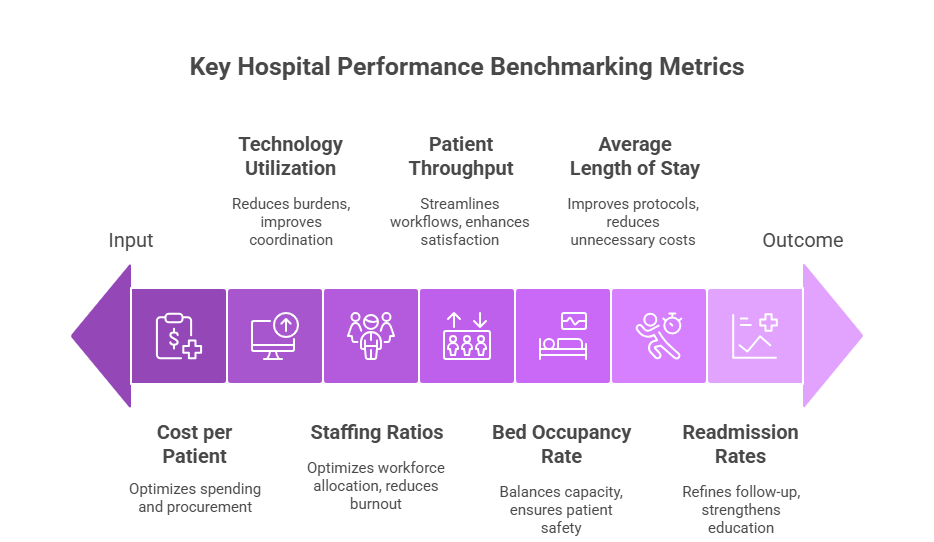Efficiency has become one of the defining challenges for hospitals worldwide. Rising patient volumes, higher treatment costs, and limited resources are forcing providers to deliver more care with fewer inputs, all without compromising on quality or patient safety. In this environment, simply tracking internal performance is no longer enough.
Hospitals need a clear, comparative view of how they perform against industry standards and peer institutions. This is where hospital performance benchmarking comes in. By evaluating efficiency through structured metrics, hospitals can identify hidden gaps, streamline processes, and optimize resource utilization.
When approached strategically, benchmarking transforms raw data into actionable insights. Thus, helping hospitals improve care delivery, reduce costs, and build a sustainable foundation for long-term success.
Key Hospital Performance Benchmarking Metrics for Efficiency

- Bed Occupancy Rate: This metric measures how effectively hospital capacity is being utilized. An optimal occupancy rate balances efficiency and patient safety—too low indicates underutilization, while too high strains resources and impacts quality of care.
- Average Length of Stay (ALOS): ALOS reflects the efficiency of treatment pathways, discharge planning, and care coordination. Benchmarking this metric helps hospitals identify delays, improve clinical protocols, and reduce unnecessary costs while maintaining quality outcomes.
- Patient Throughput & Wait Times: The speed with which patients move through emergency, outpatient, and inpatient services is a direct indicator of efficiency. Benchmarking throughput and wait times enables hospitals to streamline workflows and enhance patient satisfaction.
- Staffing Ratios & Productivity: Aligning the right number of staff with patient needs is critical. Benchmarking staffing models—nurses per bed, physicians per patient load—helps hospitals optimize workforce allocation, reduce burnout, and maintain high-quality care.
- Readmission Rates: High readmission rates often signal gaps in care quality or discharge management. Benchmarking against peers helps hospitals refine follow-up care, strengthen patient education, and improve long-term outcomes.
- Cost per Patient/Procedure: This financial metric assesses the efficiency of resource utilization in delivering care. Benchmarking cost structures allows hospitals to identify areas of overspending, optimize procurement, and maintain financial sustainability.
- Technology Utilization: Adoption of EHR systems, telemedicine, and automation tools is a key driver of efficiency. Benchmarking technology usage reveals gaps in digital maturity and guides investments that reduce administrative burdens and improve care coordination.
Together, these metrics provide hospitals with a comprehensive framework to measure and improve efficiency, ensuring resources are optimized while patient outcomes remain at the center.
Nexdigm’s Approach to Hospital Performance Benchmarking
At Nexdigm, we understand that every hospital operates in a unique ecosystem, balancing patient demographics, resource availability, and regulatory requirements. Our performance benchmarking methodology goes beyond generic comparisons to deliver tailored, actionable insights that drive measurable efficiency improvements.
- Customized KPI Selection: We identify the most relevant metrics for each hospital, ensuring the benchmarking exercise aligns with the hospital’s specific goals and challenges.
- Peer & Global Comparisons: Nexdigm benchmarks hospital performance against both regional peers and leading global institutions. This dual perspective helps providers see where they stand locally while aligning with world-class standards.
- Root Cause Analysis: Rather than stopping at data gaps, our approach investigates the underlying causes of inefficiency, so hospitals can implement targeted solutions.
- Strategic Action Plans: We deliver clear, practical recommendations that hospitals can act on immediately, whether it’s optimizing patient flow, reducing overhead, or accelerating technology adoption.
- Future-Ready Insights: Nexdigm integrates emerging healthcare trends, including telehealth, AI-driven diagnostics, and value-based care models, into our benchmarking studies. This ensures hospitals remain efficient today while preparing for the demands of tomorrow.
Through this structured approach, Nexdigm transforms benchmarking from a measurement exercise into a strategic enabler, helping hospitals strengthen financial resilience, improve patient satisfaction, and achieve long-term sustainability.
To take the next step, simply visit our Request a Consultation page and share your requirements with us.
Harsh Mittal
+91 96549 82241

